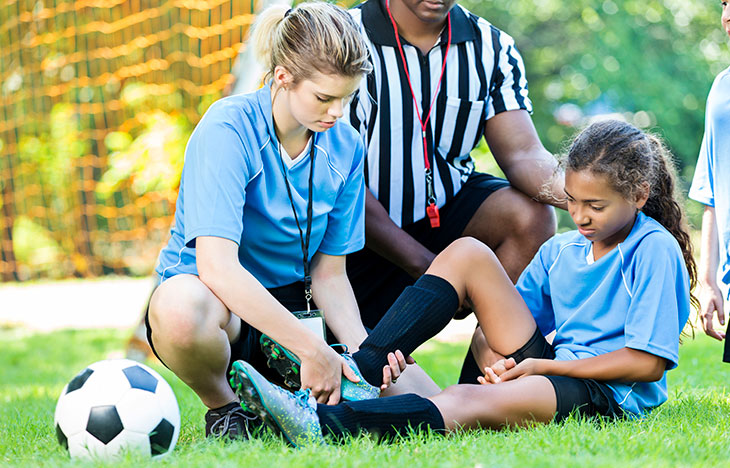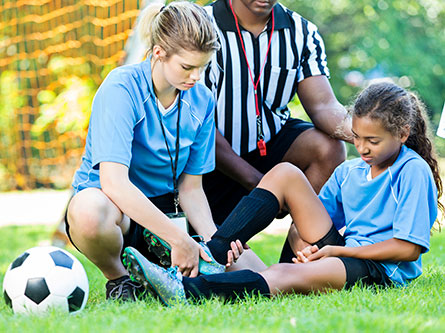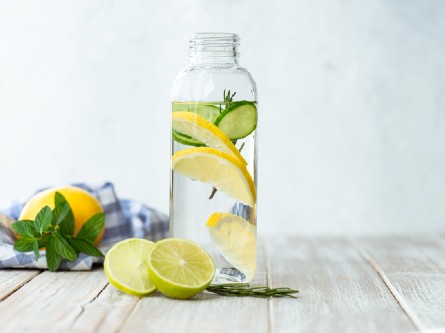
Youth sports participation has many great benefits. Playing sports as a kid can increase long-term cardiovascular health and improve social skills and overall health. But it’s no secret that taking part in sports often comes with an increased risk for injuries.
About 60 million American youth ages 6-18 will be involved in some form of athletics each year. About 44 million of those are involved in more than one sport.
On average, there are 2.6 million emergency department visits for sports-related injuries each year. This doesn’t include visits to primary care offices, which is where parents often take their kids for more minor injuries.
In their podcast “Kids Considered,” UC Davis Health pediatricians Dean Blumberg and Lena van der List discuss a variety of injuries in young athletes. They discuss an overview of the injuries, symptoms and treatment options. The pediatricians also give their research-based thoughts on how parents can help prevent injuries in their children.
Listen to this Kids Considered episode: Youth Sports Injuries - Part 1 (upper extremity injuries)
Listen to this Kids Considered episode: Youth Sports Injuries - Part 2 (lower extremity injuries)
Difference between strains and sprains
Among the more common injuries are sprains and strains. Strains happen when a muscle or tendon is torn or stretched. A sprain is an injury to a ligament.
As we talk about sports injuries like these, it's helpful to know the difference between tendons and ligaments. Tendons connect muscle to bone. Ligaments are tough, non-stretchable fibers that connect bone to bone.
Acute injuries vs. overuse injuries
Athletes can experience two different types of injuries: acute or overuse.
Acute injuries are injuries that occurred in a single moment, like a broken bone or ankle sprain.
Overuse injuries happen with repeated trauma over time. This type of injury make up about half of all sports medicine injuries. They typically involve damage to the bone, muscle, ligament, or tendon caused by repetitive stress without allowing time for the body to heal.
Overuse injuries usually shows up slowly over time and in stages. This could include initial pain after the activity. Then the athlete may start feeling pain during the sports activity, but it doesn't usually restrict performance. That can often grow into pain during the activity that hinders performance. Finally, the athlete can experience a chronic, persistent pain. If possible, try to catch these injuries in the first stage to keep them from getting worse.
Why are kids more at risk for injury?
Young athletes are more prone to injury than adults because their bones have open growth plates. These are areas of tissue at the end of bones that allow for continued growth. The growth plates provide an area of weakness in a pediatric bone and are at increased risk for injury.
Learn more about growth plate fractures
View the services and surgeries offered at UC Davis Sports Medicine
Learn about UC Davis Health's world-class orthopaedic care
Upper extremity injuries: wrists, shoulders and elbows
1. Wrist injuries
Wrist fractures are the most common fracture in kids because they fall often.
Acute wrist injury
One way children hurt their wrists is known in the medical world as FOOSH (fall on outstretched hand). This can happen if kids are riding a bike or running and try to brace for the fall with their hands. Symptoms of an acute wrist injury involve pain at the site of the injury, swelling and sometimes deformity of the wrist. If you have concerns that your child has a wrist injury, see your pediatrician.
An X-ray is the next step to determine the extent of the injury. If it's a wrist fracture, most kids heal in a cast for four-six weeks or sometimes even a splint, depending on the type of fracture and where it is. Your child's pediatrician can help guide the specific treatment.
2. Shoulder and elbow injuries
About one-third of baseball pitchers will experience shoulder or elbow pain at some point during their participation. These are overuse injuries.

Little league shoulder
Little league shoulder is common between ages 11-16. It occurs due to stress placed on the shoulder from the action of throwing a baseball. The athlete will typically have pain in the upper arm closest to the shoulder, decreased shoulder range of motion, and pain with resisted external rotation. X-rays may show an issue at the growth plate. It may take rest for six weeks to three months to heal, in addition to physical therapy.
Little league elbow
Little league elbow is most common in ages 8-15. It's caused by repetitive pulling forces on one of the growth plates in the elbow. This happens during the phase of the throw when the athlete brings the ball back (late cocking phase) and accelerates their arm to throw the pitch. An athlete may experience aching or sharp pain and swelling on the inside of the elbow. Like all overuse injuries, it may start off with pain during pitching only, and then progress to constant pain. Treatment involves rest for six weeks to three months, as well as physical therapy.
Preventing young baseball player shoulder and elbow injuries
It's important for parents and adults to help prevent overuse injuries in their young athletes. Preventing pitching injuries can include a few things:
- Ensure players are using proper technique during throwing. This will help prevent any awkward repetitive motion that could cause injury.
- Don't have your child specialize in a single sport at a young age. Several studies of professional baseball players demonstrated that those who played only baseball prior to high school have higher rates of injury. Because of this, it's recommended that children avoid specializing in a single sport until high school, or better yet, college.
- All youth baseball players should abide by pitch count. The pitch count may change, depending on the age of the player and how many days of practice or games they've had in a row. USA Baseball and Major League Baseball (MLB) have teamed up to help players reduce the number of arm injuries.
View the Pitch Smart guidelines for safe pitching practices and pitch counts based on age
3. Shoulder dislocation and partial shoulder dislocation
The shoulder is the most dislocated joint in young people. A shoulder dislocation is where the upper arm bone, called the humerus, comes completely out of the shoulder socket. This happens more in male athletes.
A partial shoulder dislocation is where the upper arm bone slides out of the shoulder socket and then back in. This happens more in female athletes.
Causes of shoulder dislocation
Shoulder dislocation typically occurs when force is applied to the arm as it's held away from the body while the hand is moving away from the body. This happens often in football, rugby, and lacrosse. It can also happen in other sports where a player may fall while they're going fast, such as in soccer or skiing. It can also happen while hanging, such as in gymnastics and rock climbing.
Symptoms and treatment of shoulder dislocation
After a dislocation, there will be immediate swelling, pain, and immobility of the joint because it's out of the socket. The person's shoulders will likely be lopsided. Initial treatment for a dislocation is to get the arm back in the correct place. This should only be done by a trained professional. You don't want to damage the area more than it's already been damaged.
Once it's been relocated, it should be immobilized in a sling. The athlete should rest from their sport for at least six weeks. Physical therapy is recommended after the swelling has gone down. The chance of a dislocation happening again is about 65-75% in people younger than 20.
Sometimes surgery is needed to prevent this from happening again. If an athlete has surgery, they should stay away from playing for about nine-twelve months.
Lower extremity injuries: ankles, feet, legs and knees
4. Ankle sprains
Ankle sprain or rolled ankle is the most common acute injury seen at health care clinics. But most people don't even go to the doctor. After an ankle sprain, you may have bruising, swelling, and pain on the outside of the ankle, usually just under the outside ankle bone.
When to get an x-ray for an ankle sprain
If your child has hurt their ankle, you should take them to get an X-ray if they have either:
- inability to bear weight (can't take four or more steps) at the time of injury AND at the medical appointment.
- pain or tenderness at any of the bony parts of the ankle or foot, such as the base of the pinky toe bone.
Slow return to play after ankle sprain
If an X-ray isn't needed and it's just a sprain, make sure there is a phased return to play.
The acronym RICE (rest, ice, compression, and elevate) should be the first step toward recovery. Use a wrap or ace bandage to compress the ankle. It's recommended to take ibuprofen (such as Advil or Motrin) or acetaminophen (such as Tylenol) and start putting weight on the ankle as tolerated. When the pain and swelling have decreased, move ahead to calf strengthening exercises.
Once that feels good, restore coordination and agility as an athlete. Examples include using a balance board or standing on one leg while throwing a ball back and forth with someone. These exercises will help strengthen the ankle and regain balance. Move on to sports-specific skills and then return to practice.
Recovery time is different for each person. These return-to-sport phases typically take one-two weeks. If it's been two weeks and there's still quite a bit of pain or swelling, it might be worth talking to a doctor to see if there was a missed fracture.
Learn more about recovery from a sprained ankle
5. Heel pain (Sever's disease)

Sever's disease is caused by inflammation of the Achilles tendon, where the tendon attaches to the heel bone at a growth plate. The thick tendon at the back of the ankle is the Achilles tendon. Sever's disease occurs in children ages 8-14 once the growth plate fuses. It's more common in males and athletes who play sports that have frequent ground contact. Sever's disease can be worse in kids who wear cleats.
This acute injury usually involves a lot of pain when the heel is squeezed at the point where the Achilles tendon attaches. Treatment includes icing after activity, calf stretches, heel cup shoe inserts and arch supports for flat feet.
Learn more about the signs and symptoms of Sever's disease
6. Shin splits and stress fractures
Shin splints
Shin splints are the most common source of pain for runners but can be seen in other athletes. Shin splits usually start as mild soreness all over the shin area and pressure in the shin when running. This is caused by the muscles and tendons around the shin becoming inflamed from use.
Stress fracture
Shin splints can be confused with stress fractures in the shin, which often happen for athletes in a high-impact sport, dancers or competitive runners. The big difference is that stress fractures lead to pain in a very specific area of the shin. Pain is also felt before and after running, and it gets worse over time. X-rays may miss stress fractures in about two-thirds of cases, because stress fractures are very small.
Treatments for shin splints and stress fractures
Shin splints and stress fractures are treated differently. Shin splits can be relieved with icing, rest, or switching to a lower impact sport like swimming or bicycling. It helps to wear supportive running shoes and switch out running shoes when they get worn down. Experts say you should change running shoes about every 6 months or 400-500 miles, depending on how much you exercise.
Stress fractures need an evaluation from an orthopaedic or sports medicine specialist. People with stress fractures should take a break from their sport for about 6 weeks. The area may need to be casted or put in a walking boot to allow for more complete healing.
7. ACL tear and meniscus injury
The ACL (anterior cruciate ligament) is one of the four ligaments that stabilize the knee. It connects the thigh bone (femur) to the large shin bone (tibia). ACL tears most commonly occur from a sudden stop, pivoting, or knee hyperextension when landing from a jump.
In about 70% of ACL tears, there is also a meniscus injury. The meniscus is the rubbery cartilage that acts as a shock absorber between your shin bone and thigh bone. It's most common in ages 11 and older and happens more often in females. Girls soccer, football, girls basketball, gymnastics and lacrosse are the top sports that lead to ACL tears.

Symptoms and diagnosis of ACL tear
The main symptom of an ACL tear is immediate swelling. Most people feel a pop when it happens. They also typically have an inability to bear weight on the leg and feel unstable. This is because that ligament is very important to creating stability in your leg.
X-rays are not usually used for diagnosing ACL tears because there is no fracture. Instead, health care providers normally order an MRI, which is the best way to visualize and study the ligaments.
Plyometric and strength training geared at strengthening the hips, hamstrings, and core can help reduce ACL injuries by nearly 75%, especially in teen girls.
Treatments for ACL tear
Surgery is the main treatment option. It usually happens once the initial swelling has gone down. Typically, athletes can return to their sport about nine months after surgery. There have been studies that show the reinjury rate is much higher if the athlete returns early, such as at six months. Most sports medicine physicians will say return between nine-twelve months.
How can parents and coaches prevent injuries in kid athletes?
Parents and coaches should encourage young athletes to take at least one day per week as a rest day away from the sport. This will allow the body to recover. Athletes should wear the right gear and make sure it fits correctly.
Coaches should add in strength training and stretching, teach proper technique, and ensure their athletes stop activity if there's any pain. Young athletes should be encouraged to drink water regularly.
Research shows that kids who play a single sport at an early age are at increased risk for injury compared to those who play multiple sports. Parents can help their young athletes by allowing their kids to play multiple sports, ideally until they're in college. This helps prevent overuse injuries because children aren't doing the same repetitive motion all year, as happens playing a single sport.
Read: 5 reasons you want your kid to be a multi-sport athlete (ESPN)
View services and surgeries offered at UC Davis Sports Medicine




